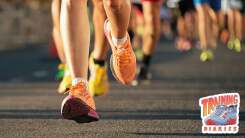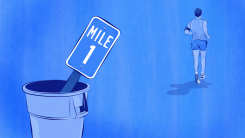Meredith’s Training Diary: My Favorite Way to Fuel for a Marathon

Welcome to Training Diaries, a Lifehacker series about my journey to the 2023 TCS New York City Marathon. This series will cover all the ups, downs, and hill repeats on my journey to the biggest marathon in the world. Leading up to race day on Sunday, Nov. 5, I’ll go over proper fueling, injuries and setbacks, treadmill tips, wardrobe malfunctions, long run logic, and just generally reflect on what it takes to cross a marathon finish line. I’m guided by a mantra both corny and true: A marathon is actually hundreds of miles; race day just happens to be the last 26 or so.
One of the most common questions I get asked by non-runners is where do you get the energy? Whether they mean this rhetorically or literally, it’s a good question. How do marathon runners fuel themselves to run 26.2 miles?
I’ve thrown around the term “fueling” in previous posts, but today, it’s time to dig in. As your long run distances increase during a marathon training plan, your body requires more energy and fluids to keep going at a sustainable pace for hours at a time. Unfortunately, this is one of the most overlooked aspects of distance running. Learning how and when to properly fuel during long runs (with gels, sport drinks and other easily digestible carbohydrates) can make the difference between hitting the wall at mile 20 or feeling strong all the way to the finish line.
I love using gels for energy during long runs
When first beginning to use gels and other fuels, it’s all about strategy and experimentation. You’re training your body not only to run increasingly long distances, but also to handle processing nutrition on-the-go.
If you’re unfamiliar with gels, picture a syrupy Go-Gurt-like packet of quick energy. Most advertise a prime combination of carbs, caffeine, and amino acids. I like to describe them as “sugar shampoo,” but for some reason my runner friends find this “off-putting” and “gross.” My preference in gels is aptly named Gu. Other runners swear by Gatorade chews, Snickers bars, or even some loose dates in a Ziploc bag. Again, you need to strategize and experiment with what works best for your body (and your budget—those Gu gels do cost me a pretty penny).
I can’t emphasize this enough: You must experiment during training runs to see what your stomach can comfortably digest. The sugars and electrolytes in most gels and sport drinks can cause gastrointestinal distress if too much is consumed at once. Start with one gel every 45-60 minutes and assess hydration needs at the same time. Over several long runs, slowly increase gel and fluid intake as needed to determine the right balance.
It is also crucial to fuel intake with hydration. Aim to drink at least 4-6 ounces of fluid with each gel to help it digest smoothly. Additionally, alternating between gels and other easily digestible carbs like hard chews or even gummy bears can provide variety to one’s fueling strategy.
One last key factor is timing. Taking a gel 5 minutes before hitting a big hill or starting a faster paced segment of a run ensures your blood sugar levels are peaking right when the extra energy is needed most. Waiting until you feel depleted to fuel up often means it’s too late to boost your performance for the harder section ahead. With practice, marathoners learn to anticipate fueling needs and properly supplement long runs with gels and hydration at just the right times.
How to fuel leading up to race day
I could write about how you’re supposed to alter your diet for months in order to get the most out of your training, but that would be hypocritical given my current levels of indulgence. (What can I say? All these long runs have turned me into an insatiable monster.) Instead, let’s focus on the day before, and the morning of the race—times when what and when you eat and drink can have a big impact on your performance.
What to eat the day before a marathon
-
Carbo-load! For the 3 days leading up to the marathon, increase your carbohydrate intake to 70% of your total calories. Good carb sources are whole wheat pastas, potatoes, rice, oats, etc.
-
Eat familiar foods to avoid GI issues. Now is not the time to try new exotic dishes. Stick to the routine meals you know your body can tolerate.
-
Hydrate well in the days before. Aim for 12-16 cups of water daily to store water in your muscles. Reduce fiber intake to avoid GI problems.
-
Have a big carb-filled dinner the night before. Pasta primavera, rice and beans, pizza, etc.
What to eat on the morning of a marathon race: Breakfast
-
Eat 2-4 hours before the starting gun. Set your alarm early to allow time to digest.
-
Go for easily digested carbs and a little protein. Oatmeal, whole wheat toast, banana, peanut butter, eggs.
-
Drink 16oz of water or sports drink. Hydrate well in the morning.
-
Avoid high fiber, high fat, or high protein foods which can cause GI distress.
What to eat during a marathon
-
Take gels or chews every 45-60 minutes once the race starts.
-
Drink 4-8oz of water or sports drink every 20-30 minutes at water stations. Keep hydrating!
-
Stay on top of your hunger, fatigue, or headaches. One runner once told me “If you start to feel thirsty, you’re too late.” What they meant was this: Fuel your body before it starts sending signs you need to fuel more.
-
“Nothing new on race day.” This goes for gear and nutrition alike. Don’t be tempted by a station with new gels or drinks during the race. Always go with what you’ve trained with.
What to eat to finish a marathon strong
-
The last six miles are critical. From my experience, a marathon feels like a twenty-miler plus the most challenging 10k of your life. Take gels every 30 minutes at this point.
-
If you fall behind on fueling, don’t take multiple gels at once. Space them out.
-
Drink regularly to avoid hitting the wall from dehydration.
While mastering the nuances of mid-run fueling takes some trial and error, my experience suggest it can pay huge dividends on race day. By dialing in a personalized nutrition plan during training, runners can avoid the dreaded bonk and have energy left to surge to the finish. The marathon distance is as much a test of proper fueling as it is endurance. Practicing with gels and sport drinks prepares one’s body to go the distance.



